
Sponsored by: SRK Consulting
Bootprints in Bear Country: Discovery History and Geology of the Malmyzh Cu-Au porphyry cluster, Khabarovsk krai, Russia
by Mac Canby - Senior President of Exploration for Freeport-McMoRan
Abstract - Malmyzh is a district-scale cluster of porphyry Cu-Au deposits located in Khabarovsk krai, eastern Russia. The district contains >5Mt Cu and >9Moz Au in a grass-roots discovery made in late 2008 by Freeport/Phelps Dodge Exploration. Porphyry affinity and significant potential of the district was initially recognized by Russian geologists working for Phelps Dodge Exploration in 2005, with initial drill discovery made in the winter of 2008-2009, when four of seven initial holes intersected ore-grade Cu-Au mineralization. Previously known as a non-economic placer gold occurrence, 1970s Soviet prospecting at Malmyzh identified low-grade vein/veinlet Au occurrences, considered at the time as the source of the widespread, low-grade, fine-grained alluvial gold. Porphyry copper potential, including possible supergene enrichment, was recognized by the Soviet exploration teams, but was never investigated. The district’s placers were explored by many shallow drill holes but no deep drilling to investigate hard rock metal potential was ever done.
The four deposits containing resources and ten additional mineralized centers so far identified at Malmyzh comprise typical porphyry Cu-Au stockwork and disseminated zones associated with quartz diorite to granodiorite porphyries and intrusion breccias that intrude a relatively monotonous sequence of hornfelsed, fine-grained, thinly-bedded siliceous clastic rocks. Mineralization occurs in both intrusions and the surrounding stockworked sediments. Centrally-located quartz-magnetite-biotite+K-feldspar alteration is variably overprinted and surrounded by phyllic alteration. The geometry of the deposits ranges from shallow bowl-like shapes with low stripping ratio (Valley), to steeply-dipping pipes (Central, Flats, Freedom NW prospect) or northeast-elongated higher-grade zones (Freedom) within surrounding low-grade halos. Mineralization at the ABV prospect appears to be a partial annulus, developed around a large but barren magnetic high. Intramineral brecciation of earlier porphyry mineralization is widespread in the Freedom Northwest prospect, which has returned long well-mineralized intercepts but is not yet included in the announced resource base. Saprolitic weathering and supergene leaching of Cu, likely augmented by the widespread quartz-sericite-pyrite alteration which surrounds and locally overprints the deposits, resulted in subdued surface Cu geochemistry, and generated thin supergene enriched profiles (tens of meters) with grades locally of >1% Cu. Small, late-stage intermediate-sulfidation quartz-pyrite+carbonate Au-Ag-polymetallic veins occur locally both within and around the deposits. Advanced argillic alteration is notably absent, except for small linear zones identified in the Bikha area. The deposits contain simple Cu mineralogy consisting of hypogene chalcopyrite and minor bornite, and limited supergene chalcocite, appear metallurgically straightforward, and so far lack any significant deleterious elements. Au:Cu ratios (gram : percent basis) range from ~1:4 (Central) to ~3:4 (Freedom).
Phelps Dodge Exploration acquired the initial 20-year exploration and mining license in 2005, and as a result of the 2008-09 financial crisis and a strategic shift away from Russia after acquisition by Freeport in 2007, entered a JV with Fortress Minerals (subsequently IG Copper) in 2009. IG Copper and its various partners, most notably Eurasian Minerals (now EMX Royalty), advanced the project through license expansion, drilling and other work leading to an initial NI 43-101 compliant resource of 1.661Bt at 0.34% Cu and 0.17g/t Au in 2015. A corresponding, non-compliant, Russian GKZ (state reserves committee) C1+C2 resource contains 1.261Bt at 0.41% Cu and 0.22g/t Au. As operator, IG Copper and partners accomplished several outstanding community and operational achievements in Russia, including Explorer of the Year award (Minex, 2015), nominations of its key personnel with business and geologic awards, and finally in July 2016, receipt of Strategic Industries Law (SIL) approval, allowing 100% foreign ownership and development of a major ‘strategic deposit.’ IG Copper’s in-house geologic, drilling, modelling and operational teams accomplished remarkably cost-effective and safe exploration programs at Malmyzh. This, and continuing exploration success, established credibility and an excellent working relationship with Russian regulatory, business community and other local stakeholders - all at a time when international relations were disintegrating as a result of events in Ukraine. The latter ultimately led Freeport to divest of its interest completely by late 2018.
Phelps Dodge’s regional porphyry search started in ~2003, following a previous successful regional Russian gold program that discovered the Svetloye high-sulfidation Au deposit in Khabarovsk krai. Keys to success in identifying a potentially-economic deposit at Malmyzh were: 1) training key Russian geologists on the empirical characteristics of porphyry deposits, in particular the field- and literature-appearance of leached caps in historic Soviet geologic literature; 2) restricting target search to areas within 100 km of a road, railroad, navigable river or coastline; 3) ignoring geologic preconceptions of the region as a ‘tin province,’ lacking ability to host major copper deposits, and: 4) funding a multi-year effort of prospect exams. Of five targets eventually acquired in the region, two weakly-mineralized targets were drilled prior to the Malmyzh discovery, and two additional weakly-mineralized/barren porphyry targets drilled in parallel. Malmyzh was the third target drilled in the program. The prospect has a distinct Cu-Au geochemical signature, unlike the Cu-Mo affinity of three of the other prospects acquired. Initial field visits identified leached, stockwork-veined, but geochemically barren qtz-sericite-pyrite altered sediments in a small quarry excavated for road metal. Later field work identified two small (<30m diameter) areas of float with quartz-magnetite veined rock containing traces of copper oxides, but in general float was disproportionately represented by more durable but barren qtz-sericite-iron oxide leached cap, and boulders of mostly unaltered late-stage hornblende diorite. These observations somewhat downgraded the project’s perceived prospectivity and internal ranking, until the initial drilling confirmed the existence, potential scale, and grade of porphyry Cu-Au mineralization.
Key prospect-scale target-definition criteria, ranked roughly by effectiveness, were soil geochemistry, ground magnetics, and float rock-chip mapping and geochemistry. Individual deposits at Malmyzh show a wide range of responses, making target prioritization only partly effective: the largest deposit, with largest sub-cropping ‘footprint’ (Valley), had one of the less impressive geochemical and magnetic responses, delaying its discovery until the second phase of drilling.
This talk will focus on the discovery history, general geology, and exploration characteristics of the Malmyzh deposits.
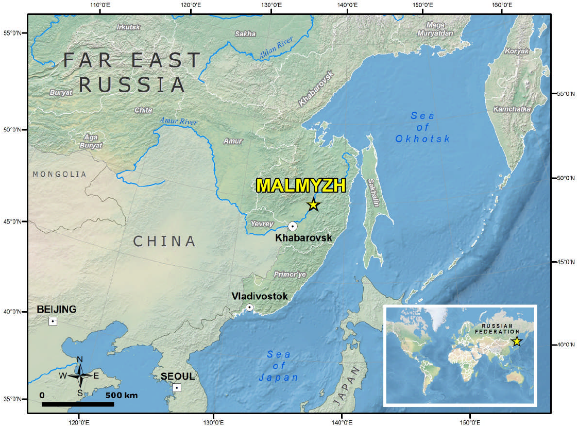
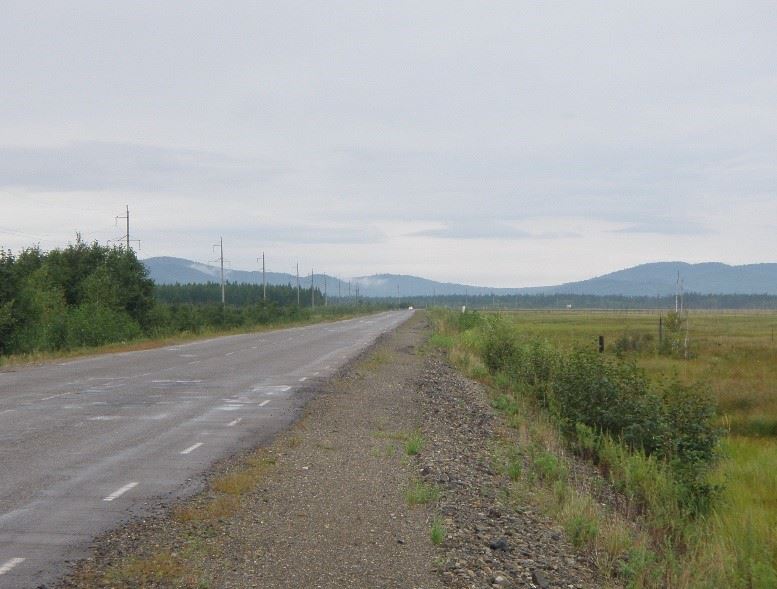
Figure 1. Left; location map (courtesy Wardell Armstrong 43-101, 2015); right: Malmyzh hills looking northwest, from Khabarovsk-Komsomolsk highway. Deposits occupy lower flanks of hills at left.

Figure 2. Typical geochemically barren, hematite- and jarosite-goethite leached cap developed in qtz-sericite-pyrite veined sandstone and arkose from various prospects at Malmyzh.
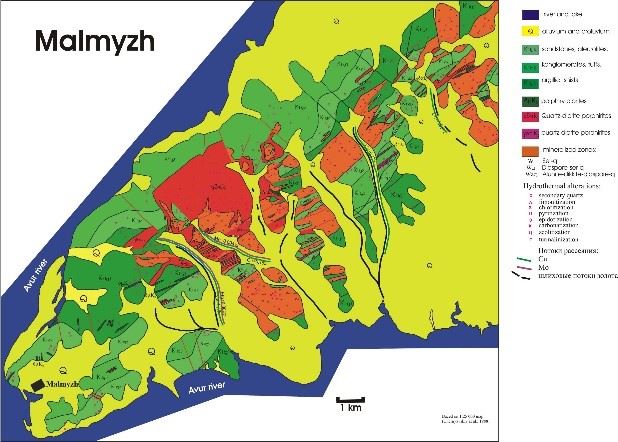
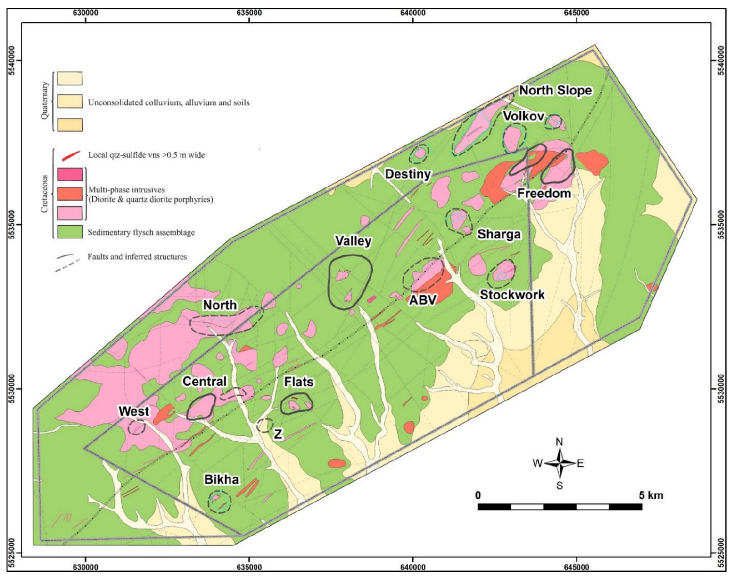
Figure 3. Right: early (~2005) compiled district prospect map based on historic Soviet data; Left: district at ~2014 showing subsequently-defined deposits and prospects (Oreol consultants, 2014). Maps roughly at same scale.
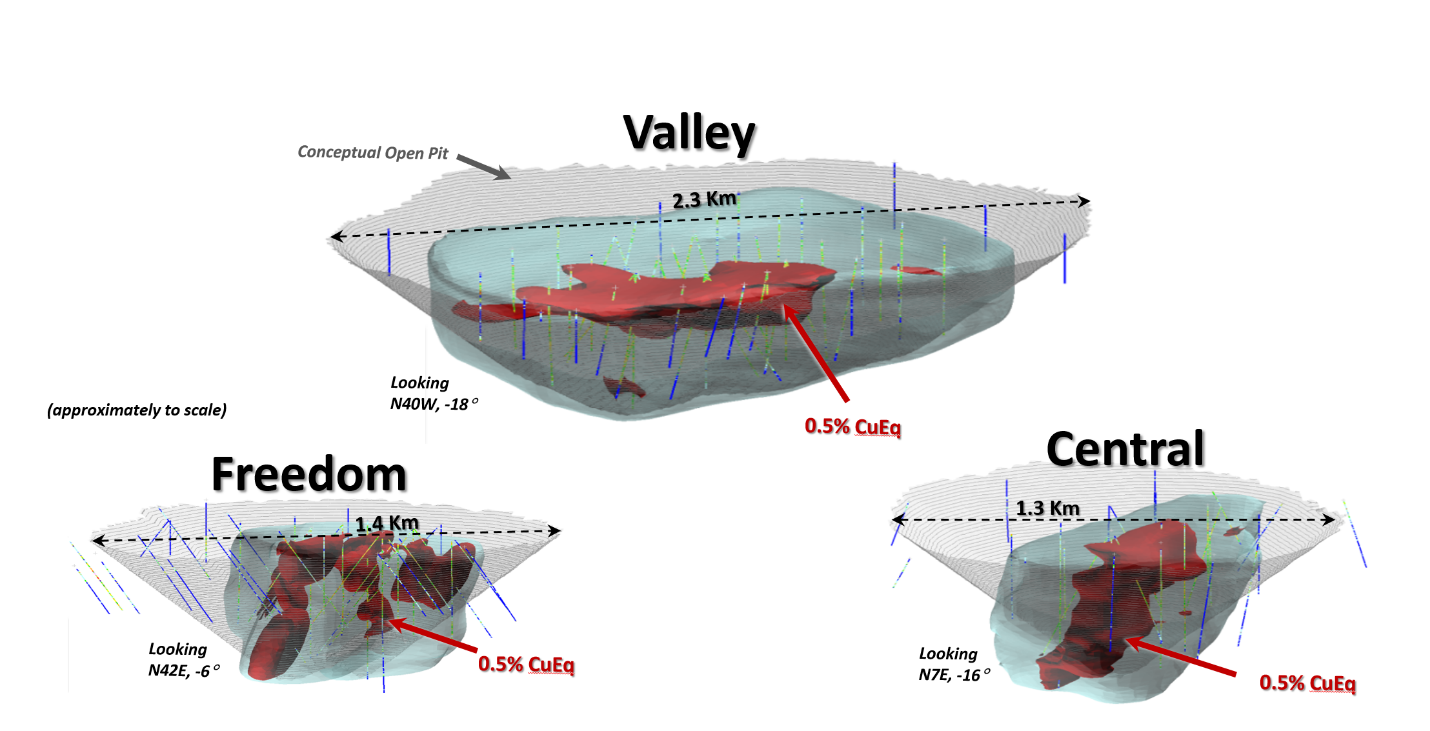
Figure 4. Simplified view of grade shells and geometry of higher-grade mineralization, Malmyzh deposits. (Courtesy IG Copper, presentation Sept. 2016).
 Bio - Vertrees M. “Mac” Canby is currently Senior President Exploration for Freeport-McMoRan, based in Phoenix, AZ. He has worked for Freeport and Phelps Dodge (acquired by Freeport in 2007) in various exploration positions since 1987, starting in the Great Basin and western United States, central and South America, and more recently Eurasia and Africa. Mr. Canby received his B.Sc. degree in Geological Engineering from New Mexico Institute of Mining and Technology in 1987, and M.Sc. in Geology from University of Nevada/Reno in 1992. He and his team members have participated in copper and gold deposit discoveries in Asia, Europe, and the Americas. Mac is a Fellow and former Vice President/Europe of the Society of Economic Geology, a Fellow of the London Geological Society, and a member of the Colorado Scientific Society, the Geological Society of Nevada, and the Denver Regional Explorationist’s Society. He and team members received Discovery Medals of the Russian Federation for the Svetloye high-sulfidation Au deposit and Malmyzh Cu-Au deposits, and the 2016 Thayer Lindsley PDAC award for the Cukaru Peki copper-gold discovery in Serbia. He and his family currently reside in Denver, Colorado, USA.
Bio - Vertrees M. “Mac” Canby is currently Senior President Exploration for Freeport-McMoRan, based in Phoenix, AZ. He has worked for Freeport and Phelps Dodge (acquired by Freeport in 2007) in various exploration positions since 1987, starting in the Great Basin and western United States, central and South America, and more recently Eurasia and Africa. Mr. Canby received his B.Sc. degree in Geological Engineering from New Mexico Institute of Mining and Technology in 1987, and M.Sc. in Geology from University of Nevada/Reno in 1992. He and his team members have participated in copper and gold deposit discoveries in Asia, Europe, and the Americas. Mac is a Fellow and former Vice President/Europe of the Society of Economic Geology, a Fellow of the London Geological Society, and a member of the Colorado Scientific Society, the Geological Society of Nevada, and the Denver Regional Explorationist’s Society. He and team members received Discovery Medals of the Russian Federation for the Svetloye high-sulfidation Au deposit and Malmyzh Cu-Au deposits, and the 2016 Thayer Lindsley PDAC award for the Cukaru Peki copper-gold discovery in Serbia. He and his family currently reside in Denver, Colorado, USA.